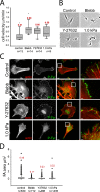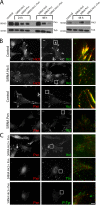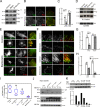Myosin II activity regulates vinculin recruitment to focal adhesions through FAK-mediated paxillin phosphorylation
- PMID: 20308429
- PMCID: PMC2845065
- DOI: 10.1083/jcb.200906012
Myosin II activity regulates vinculin recruitment to focal adhesions through FAK-mediated paxillin phosphorylation
Abstract
Focal adhesions (FAs) are mechanosensitive adhesion and signaling complexes that grow and change composition in response to myosin II-mediated cytoskeletal tension in a process known as FA maturation. To understand tension-mediated FA maturation, we sought to identify proteins that are recruited to FAs in a myosin II-dependent manner and to examine the mechanism for their myosin II-sensitive FA association. We find that FA recruitment of both the cytoskeletal adapter protein vinculin and the tyrosine kinase FA kinase (FAK) are myosin II and extracellular matrix (ECM) stiffness dependent. Myosin II activity promotes FAK/Src-mediated phosphorylation of paxillin on tyrosines 31 and 118 and vinculin association with paxillin. We show that phosphomimic mutations of paxillin can specifically induce the recruitment of vinculin to adhesions independent of myosin II activity. These results reveal an important role for paxillin in adhesion mechanosensing via myosin II-mediated FAK phosphorylation of paxillin that promotes vinculin FA recruitment to reinforce the cytoskeletal ECM linkage and drive FA maturation.
Figures








Similar articles
-
Effects of substrate stiffness and actomyosin contractility on coupling between force transmission and vinculin-paxillin recruitment at single focal adhesions.Mol Biol Cell. 2017 Jul 7;28(14):1901-1911. doi: 10.1091/mbc.E17-02-0116. Epub 2017 May 3. Mol Biol Cell. 2017. PMID: 28468976 Free PMC article.
-
Phospho-regulated tethering of focal adhesion kinase to vinculin links force transduction to focal adhesion signaling.Cell Commun Signal. 2025 Apr 21;23(1):190. doi: 10.1186/s12964-025-02201-3. Cell Commun Signal. 2025. PMID: 40259376 Free PMC article.
-
Roles of focal adhesions and fibronectin-mediated cohesion in proliferation of confluent fibroblasts.J Cell Physiol. 2009 Apr;219(1):194-201. doi: 10.1002/jcp.21668. J Cell Physiol. 2009. PMID: 19107843
-
Focal Adhesion's Role in Cardiomyocytes Function: From Cardiomyogenesis to Mechanotransduction.Cells. 2024 Apr 10;13(8):664. doi: 10.3390/cells13080664. Cells. 2024. PMID: 38667279 Free PMC article. Review.
-
Mechanosensitivity and compositional dynamics of cell-matrix adhesions.EMBO Rep. 2013 Jun;14(6):509-19. doi: 10.1038/embor.2013.49. Epub 2013 May 17. EMBO Rep. 2013. PMID: 23681438 Free PMC article. Review.
Cited by
-
Activation of beta 1 but not beta 3 integrin increases cell traction forces.FEBS Lett. 2013 Mar 18;587(6):763-9. doi: 10.1016/j.febslet.2013.01.068. Epub 2013 Feb 8. FEBS Lett. 2013. PMID: 23395612 Free PMC article.
-
aPKCζ affects directed cell migration through the regulation of myosin light chain phosphorylation.Cell Adh Migr. 2017 Jul 4;11(4):347-359. doi: 10.1080/19336918.2016.1225631. Epub 2016 Aug 19. Cell Adh Migr. 2017. PMID: 27541056 Free PMC article.
-
Spatiotemporal control of actomyosin contractility by MRCKβ signaling drives phagocytosis.J Cell Biol. 2022 Nov 7;221(11):e202012042. doi: 10.1083/jcb.202012042. Epub 2022 Sep 19. J Cell Biol. 2022. PMID: 36121394 Free PMC article.
-
Fibroblasts secrete fibronectin under lamellipodia in a microtubule- and myosin II-dependent fashion.J Cell Biol. 2023 Feb 6;222(2):e202204100. doi: 10.1083/jcb.202204100. Epub 2022 Nov 23. J Cell Biol. 2023. PMID: 36416725 Free PMC article.
-
c-Abl mediated tyrosine phosphorylation of paxillin regulates LPS-induced endothelial dysfunction and lung injury.Am J Physiol Lung Cell Mol Physiol. 2015 May 15;308(10):L1025-38. doi: 10.1152/ajplung.00306.2014. Epub 2015 Mar 20. Am J Physiol Lung Cell Mol Physiol. 2015. PMID: 25795725 Free PMC article.
References
-
- Brown M.C., Perrotta J.A., Turner C.E. 1996. Identification of LIM3 as the principal determinant of paxillin focal adhesion localization and characterization of a novel motif on paxillin directing vinculin and focal adhesion kinase binding. J. Cell Biol. 135:1109–1123 10.1083/jcb.135.4.1109 - DOI - PMC - PubMed
-
- Bulinski J.C., Odde D.J., Howell B.J., Salmon T.D., Waterman-Storer C.M. 2001. Rapid dynamics of the microtubule binding of ensconsin in vivo. J. Cell Sci. 114:3885–3897 - PubMed
Publication types
MeSH terms
Substances
Grants and funding
LinkOut - more resources
Full Text Sources
Other Literature Sources
Molecular Biology Databases
Research Materials
Miscellaneous

